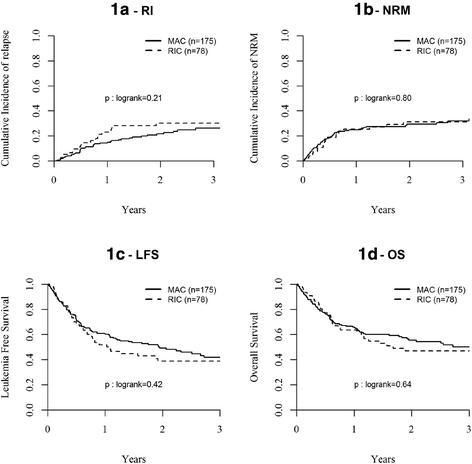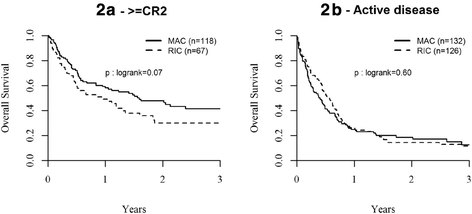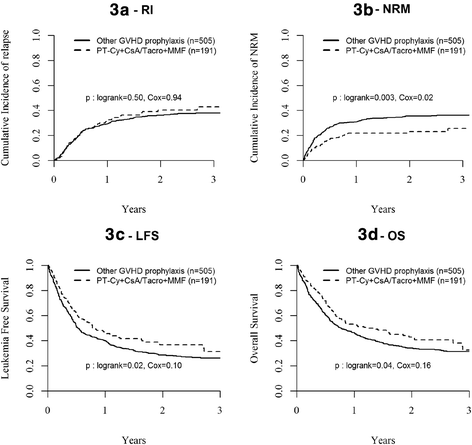Impact of conditioning intensity in T-replete haplo-identical stem cell transplantation for acute leukemia: a report from the acute leukemia working party of the EBMT
- PMID: 26980295
- PMCID: PMC4791867
- DOI: 10.1186/s13045-016-0248-3
Impact of conditioning intensity in T-replete haplo-identical stem cell transplantation for acute leukemia: a report from the acute leukemia working party of the EBMT
Abstract
Background: Increasing numbers of patients are receiving haplo-identical stem cell transplantation (haplo-SCT) for treatment of acute leukemia with reduced intensity (RIC) or myeloablative (MAC) conditioning regimens. The impact of conditioning intensity in haplo-SCT is unknown.
Methods: We performed a retrospective registry-based study comparing outcomes after T-replete haplo-SCT for patients with acute myeloid (AML) or lymphoid leukemia (ALL) after RIC (n = 271) and MAC (n = 425). Regimens were classified as MAC or RIC based on published criteria.
Results: A combination of post-transplant cyclophosphamide (PT-Cy) with one calcineurin inhibitor and mycophenolate mofetil (PT-Cy-based regimen) for graft-versus-host disease (GVHD) prophylaxis was used in 66 (25%) patients in RIC and 125 (32%) in MAC groups. Patients of RIC group were older and had been transplanted more recently and more frequently for AML with active disease at transplant. Percentage of engraftment (90 vs. 92%; p = 0.58) and day 100 grade II to IV acute GVHD (24 vs. 29%, p = 0.23) were not different between RIC and MAC groups. Multivariable analyses, run separately in AML and ALL, showed a trend toward higher relapse incidence with RIC in comparison to MAC in AML (hazard ratio (HR) 1.34, p = 0.09), and no difference in both AML and ALL in terms of non-relapse mortality (NRM) chronic GVHD and leukemia-free survival. There was no impact of conditioning regimen intensity in overall survival (OS) in AML (HR = 0.97, p = 0.79) but a trend for worse OS with RIC in ALL (HR = 1.44, p = 0.10). The main factor impacting outcomes was disease status at transplantation (HR ≥ 1.4, p ≤ 0.01). GVHD prophylaxis with PT-Cy-based regimen was independently associated with reduced NRM (HR 0.63, p = 0.02) without impact on relapse incidence (HR 0.99, p = 0.94).
Conclusions: These data suggest that T-replete haplo-SCT with both RIC and MAC, in particular associated with PT-Cy, are valid options in first line treatment of high risk AML or ALL.
Keywords: Acute Leukemia; Allogeneic stem cell transplantation; Anti-leukemic effect; Conditioning regimen; Haplo-identical donor; Toxicity.
Figures



Similar articles
-
Unmanipulated haploidentical stem cell transplantation in adults with acute lymphoblastic leukemia: a study on behalf of the Acute Leukemia Working Party of the EBMT.J Hematol Oncol. 2017 May 30;10(1):113. doi: 10.1186/s13045-017-0480-5. J Hematol Oncol. 2017. PMID: 28558762 Free PMC article.
-
Impact of conditioning intensity on outcomes of haploidentical stem cell transplantation for patients with acute myeloid leukemia 45 years of age and over.Cancer. 2019 May 1;125(9):1499-1506. doi: 10.1002/cncr.31941. Epub 2019 Jan 8. Cancer. 2019. PMID: 30620383
-
Comparative outcome of reduced intensity and myeloablative conditioning regimen in HLA identical sibling allogeneic hematopoietic stem cell transplantation for acute leukemia patients: a single center experience.Transfus Apher Sci. 2013 Dec;49(3):590-9. doi: 10.1016/j.transci.2013.07.030. Epub 2013 Aug 8. Transfus Apher Sci. 2013. PMID: 23981652
-
Comparison of reduced-intensity and myeloablative conditioning regimens for allogeneic hematopoietic stem cell transplantation in patients with acute myeloid leukemia and acute lymphoblastic leukemia: a meta-analysis.Stem Cells Dev. 2014 Nov 1;23(21):2535-52. doi: 10.1089/scd.2014.0123. Epub 2014 Sep 17. Stem Cells Dev. 2014. PMID: 25072307 Free PMC article. Review.
-
Outcomes after Haploidentical Hematopoietic Cell Transplantation with Post-Transplantation Cyclophosphamide: A Systematic Review and Meta-Analysis Comparing Myeloablative with Reduced-Intensity Conditioning Regimens and Bone Marrow with Peripheral Blood Stem Cell Grafts.Transplant Cell Ther. 2021 Sep;27(9):782.e1-782.e7. doi: 10.1016/j.jtct.2021.06.011. Epub 2021 Jun 16. Transplant Cell Ther. 2021. PMID: 34146733
Cited by
-
Haploidentical hematopoietic cell transplantation for adult acute myeloid leukemia: a position statement from the Acute Leukemia Working Party of the European Society for Blood and Marrow Transplantation.Haematologica. 2017 Nov;102(11):1810-1822. doi: 10.3324/haematol.2017.176107. Epub 2017 Sep 7. Haematologica. 2017. PMID: 28883081 Free PMC article. Review.
-
Reduced intensity conditioning regimen of fludarabine, busulfan, ATG based haploidentical stem cell transplantation for older or unfit patients.Ann Hematol. 2024 Aug;103(8):3105-3119. doi: 10.1007/s00277-024-05819-4. Epub 2024 Jun 3. Ann Hematol. 2024. PMID: 38829409
-
Myeloablative haploidentical BMT with posttransplant cyclophosphamide for hematologic malignancies in children and adults.Blood Adv. 2020 Aug 25;4(16):3913-3925. doi: 10.1182/bloodadvances.2020001648. Blood Adv. 2020. PMID: 32813874 Free PMC article. Clinical Trial.
-
Lower dose of ATG combined with basiliximab for haploidentical hematopoietic stem cell transplantation is associated with effective control of GVHD and less CMV viremia.Front Immunol. 2022 Nov 15;13:1017850. doi: 10.3389/fimmu.2022.1017850. eCollection 2022. Front Immunol. 2022. PMID: 36458000 Free PMC article.
-
Myeloablative vs reduced intensity T-cell-replete haploidentical transplantation for hematologic malignancy.Blood Adv. 2019 Oct 8;3(19):2836-2844. doi: 10.1182/bloodadvances.2019000627. Blood Adv. 2019. PMID: 31582392 Free PMC article.
References
-
- Beatty PG, Clift RA, Mickelson EM, Nisperos BB, Flournoy N, Martin PJ, et al. Marrow transplantation from related donors other than HLA-identical siblings. N Engl J Med. 1985;313(13):765–71. - PubMed
-
- Anasetti C, Beatty PG, Storb R, Martin PJ, Mori M, Sanders JE, et al. Effect of HLA incompatibility on graft-versus-host disease, relapse, and survival after marrow transplantation for patients with leukemia or lymphoma. Hum Immunol. 1990;29(2):79–91. doi: 10.1016/0198-8859(90)90071-V. - DOI - PubMed
Publication types
MeSH terms
Substances
LinkOut - more resources
Full Text Sources
Other Literature Sources

